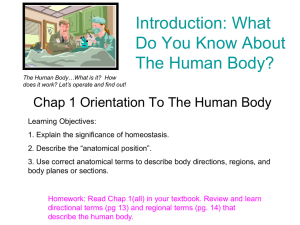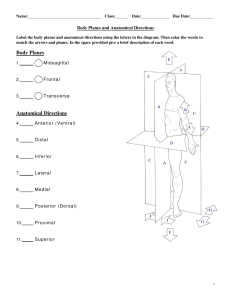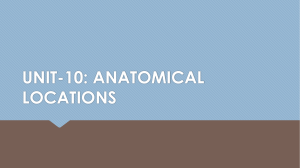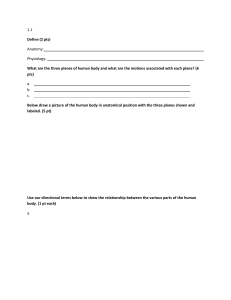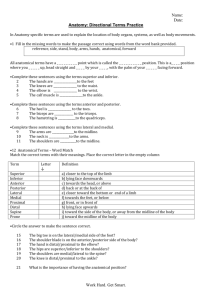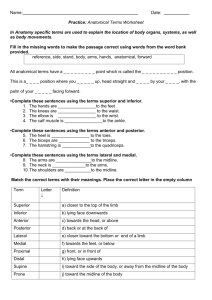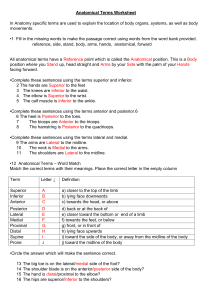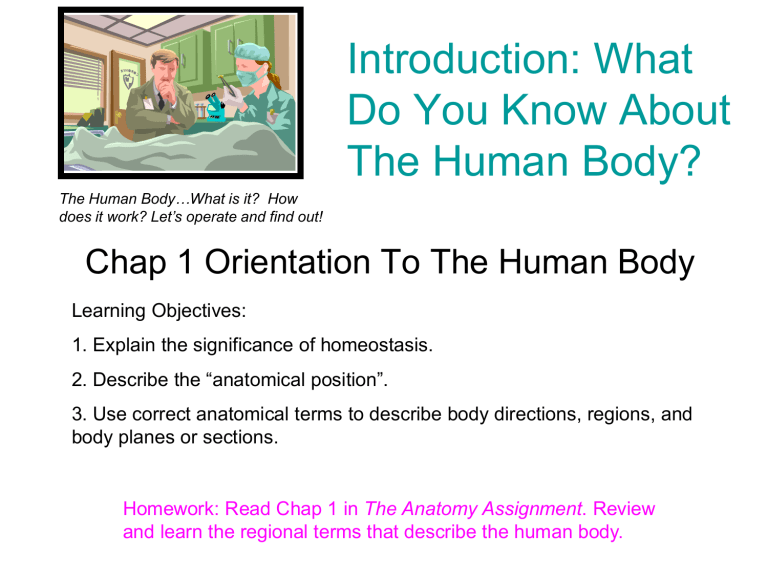
Introduction: What Do You Know About The Human Body? The Human Body…What is it? How does it work? Let’s operate and find out! Chap 1 Orientation To The Human Body Learning Objectives: 1. Explain the significance of homeostasis. 2. Describe the “anatomical position”. 3. Use correct anatomical terms to describe body directions, regions, and body planes or sections. Homework: Read Chap 1 in The Anatomy Assignment. Review and learn the regional terms that describe the human body. Problem-Solving Scenario Assume that the temperature outside is 36 degrees Fahrenheit. You are asked to stand outside, with only shorts and a t-shirt on for 4 hours. If we took your temperature with a normal thermometer, what should we expect your body temperature to be at the end of those 4 hours? Why? Homeostasis, page 2 The Anatomy Assignment • The body’s ability to maintain a relatively stable internal environment despite outside conditions • There are hundreds of systems and processes that the body attempts to maintain to stay at homeostasis including - body temperature - blood volume - heart rate - blood pressure - breathing - levels of oxygen in the blood Medical Science Our bodies are complex to say the least. Medical science attempts to organize the body in such a way that we can study and understand it. What do you know about your body? PREDICT • As you study this figure, determine precisely where you would be injured if you pulled a muscle in your inguinal region? Inguinal (groin) PREDICT • Where would you be injured if you cracked a bone in your olecranal region? Olecranal (back of elbow) PREDICT • What if you cut your fibular region? Fibular or peroneal (side of leg) EXPLORING REGIONAL TERMS • Regional terms, like the ones we just discussed, are used to designate specific body areas. • Using your textbook as a reference (page 15-16), identify and learn the regions of the human body on the handout provided by the instructor. • Estimated Time 10 – 12 minutes Regions of the Body • The “anatomical position” is palms up (anterior view). And soles of feet slightly raised to show the plantar surface of the foot. Discussion • What does “dorsal” refer to? A - On the back Discussion What term do we use to refer to the stomach surface of an animal? A - Ventral Partner Activity: Other Directional Terms Instructions: Using your textbook, Table 1.1 – Orientation and Directional Terms page 13, briefly describe the meaning of the term in your notes. Do this with a partner. Answers: What do these terms refer to? 1. Superior 2. Inferior 3. Medial 4. Lateral 5. Intermediate 6. Proximal 7. Distal 8. Superficial 9. Deep 1. Toward the head 2. Away from the head 3. Toward the midline 4. Away from the midline 5. Between 6. Close to the point of attachment of a limb 7. Farther from the point of attachment 8. Toward or at the body’s surface 9. Away from the body’s surface Planes of the Body, page 5 The body is often sectioned (cut) along a flat surface called a plane. Which of these planes would separate the woman’s arms? Wrap-up/ Review Complete the sentences using the terms superior, inferior, medial, lateral, intermediate, proximal, distal, superficial, or deep. 1) The head is ________ to the abdomen. A - superior 2) The knee is ________ to the thigh. A - distal 3) The heart is _____ to the skin. A - deep
